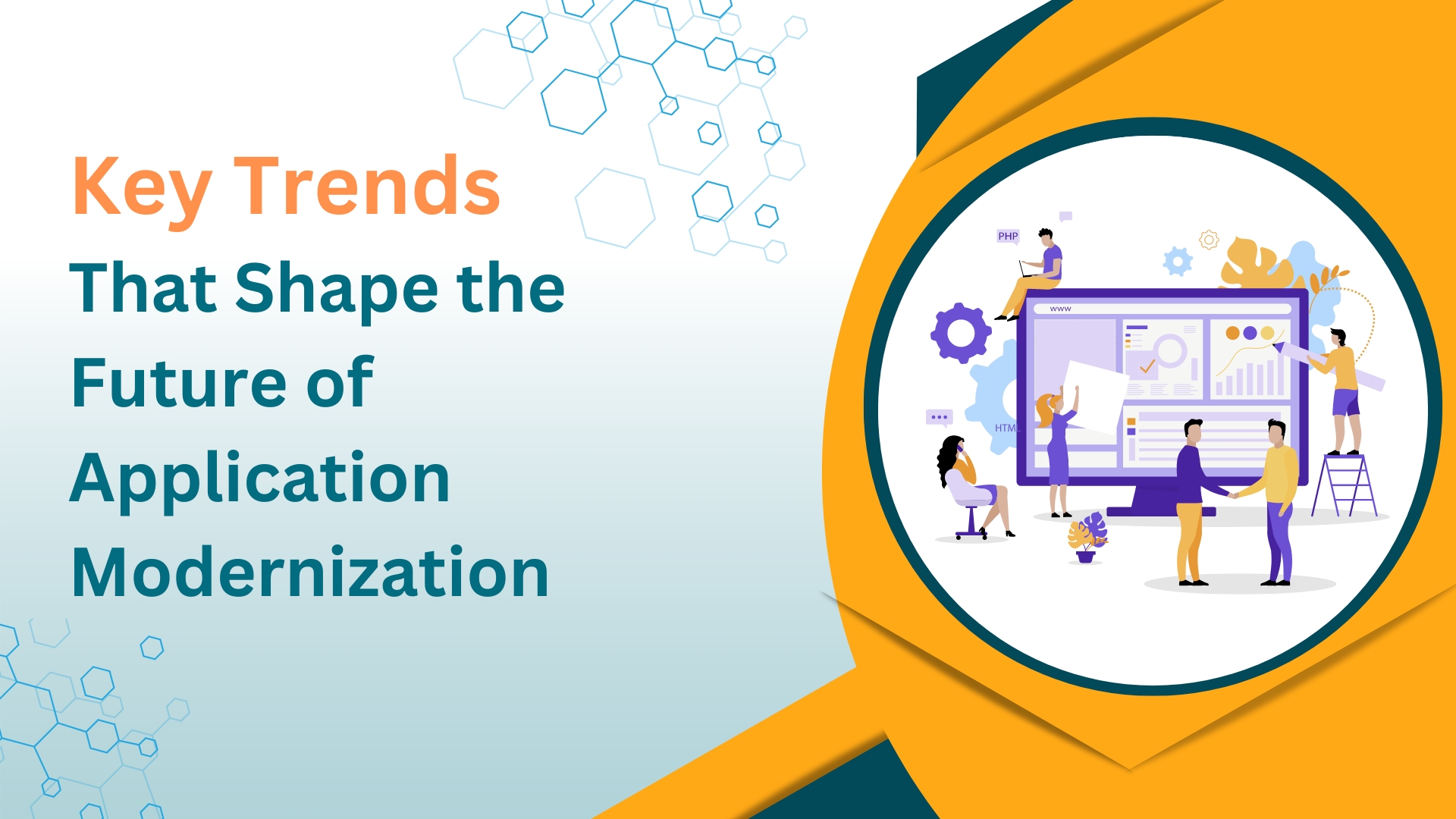In an era marked by rapid technological advancement, we are standing at the gateway to an advanced age. As evolution continues at a constant pace, the emerging trends will soon be reshaping the realm of modern systems. As application modernization has voluminous potential to tackle challenging problems, emerging technologies influence the way applications will get modernized.
This blog delves into the forefront of these trends, highlighting the most influential developments and answers, to why modernize applications.
These trends are poised to redefine the very essence of how businesses approach software development, deployment, and management, steering them toward a future of unmatched business efficiency.
What Is Application Modernization?
Application modernization is an essential process that involves upgrading or replacing existing systems with obsolete functionalities and high incompatibility with modern systems. Application modernization is a strategic approach that ensures organizations stay abreast and informed with evolving technologies, enhancing business solutions, improving efficiency, and striving to be competitive in the dynamic reign of technological innovation.
Emerging Trends in Application Modernization—What to Expect?
As technological innovation is on the rise, strategies like artificial intelligence and machine learning are becoming integral to business operations. However, let’s not limit ourselves to commonly known emerging tech disruptions.
Let’s unravel some lesser-known application modernization trends that may influence application modernization in 2024.
Cloud-Native Architecture
The shift towards cloud-native architecture is a pivotal trend in application modernization and needs a thorough cloud consultation. Cloud-native applications are designed to leverage the full potential of cloud computing, promoting scalability, flexibility, and resilience. Microservices, containers, and serverless computing are integral components of this architecture, enabling organizations to build and deploy applications more efficiently.
Containerization and Orchestration
Containers have emerged as players in the world of application development and application modernization services are uncompromisingly leveraging these approaches. Technologies like Docker provide a lightweight, portable, and consistent environment across different stages of the development lifecycle. Container orchestration tools like Kubernetes streamline the deployment and management of containerized applications, offering scalability and automation.
DevOps Integration
The integration of development (Dev) and operations (Ops) teams, commonly known as DevOps, is a trend that continues to gain momentum. DevOps services and practices emphasize collaboration, automation, and continuous integration/continuous deployment (CI/CD), ensuring a seamless and efficient development process. Organizations adopting DevOps principles experience faster release cycles, improved collaboration, and enhanced overall software quality.
Artificial Intelligence and Machine Learning
Artificial intelligence development (AI) and machine learning (ML) in application modernization transform how software behaves and adapts. AI-powered analytics, chatbots, and recommendation engines enhance user experiences, while ML algorithms automate decision-making processes. These technologies empower applications to learn and evolve, making them more intelligent and user-centric.
Serverless Computing
Serverless computing is gaining popularity as organizations seek to optimize resource utilization and reduce operational overhead. With serverless architectures, a software development company focuses more on writing code without worrying about infrastructure management. Functions are executed in response to specific events, ensuring efficient resource allocation and cost-effectiveness.
Edge Computing
As the Internet of Things (IoT) continues to grow, edge computing has become a critical trend in application modernization trends. Edge computing brings processing closer to the data source, reducing latency and enhancing real-time processing capabilities. This is particularly important for applications requiring low-latency responses, such as augmented reality, autonomous vehicles, and smart cities.
Security-First Approach
With the increasing frequency and sophistication of cyber threats, a security-first approach is a paramount application modernization trend. Secure coding practices, regular security audits, and the implementation of robust security measures are integral to protecting sensitive data and ensuring the integrity of applications. As applications become more interconnected, security must be a foundational consideration.
Hybrid cloud technology
Regardless of the era we thrive in, security issues are always a prominent concern for software development services. Considering this concern, hybrid cloud technologies offer the best solution by combining the best features of the public cloud with privately owned servers and private clouds. These clouds use edge computing to give organizations a local space to process sensitive data to prevent security breaches.
Personalization and Internet of Behavior
The Internet of Behavior or Personalization in simple terms, is a vital legacy application modernization technique as well as a crucial element of data analytics services trend that will give directions to companies to convert it into insights about their users and businesses. This data can belong to any operating facet of the business, such as Client Relationship Management (CRM) software (outside the organization) or Enterprise Resource Planning (ERP) software (within the organization). These actionable insights can be utilized by companies to tailor their future strategies and business models to personalize the experience of both clients and employees.
Composable architecture
Composable architecture includes redesigning a system’s architecture to combine diverse components that are considered based on user requirements. Companies apply this strategy to the entire tech stack, integrating it meticulously with all established business processes. This type of architecture provides high levels of flexibility and agility, speedy deployment, enhanced capabilities, and lesser data duplication.
Micro front-end modernization
This application modernization trend includes modifying individual components and technologies to speed up the application modernization process which means leveraging and reusing elements from other modernization projects with similar features and requirements. This strategy helps in saving time, resources, and work as development teams are not required to build everything up from scratch which can be a disadvantage in today’s fast-paced software development and application modernization.
Conclusion
The journey to technological evolution knows no end. This venture is sure to uncover multiple innovations and inventions that will further reshape the realm of application modernization. Eventually, what we can expect is to be more agile, more intelligent, and highly secure software. By staying on the forefront of these trends, organizations can ensure their applications remain responsive to user needs, and resilient in the face of technological and market challenges.
